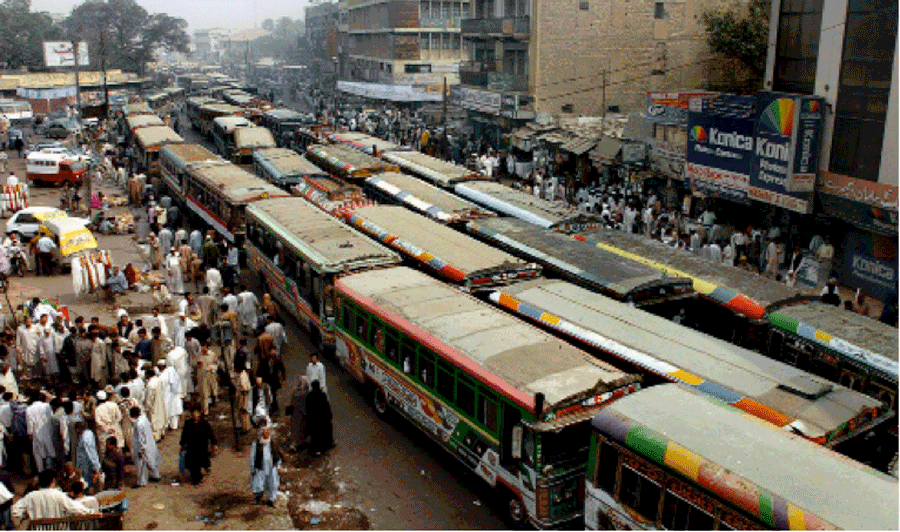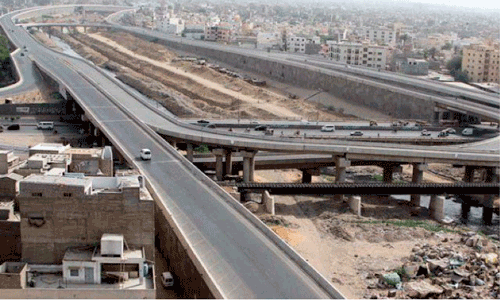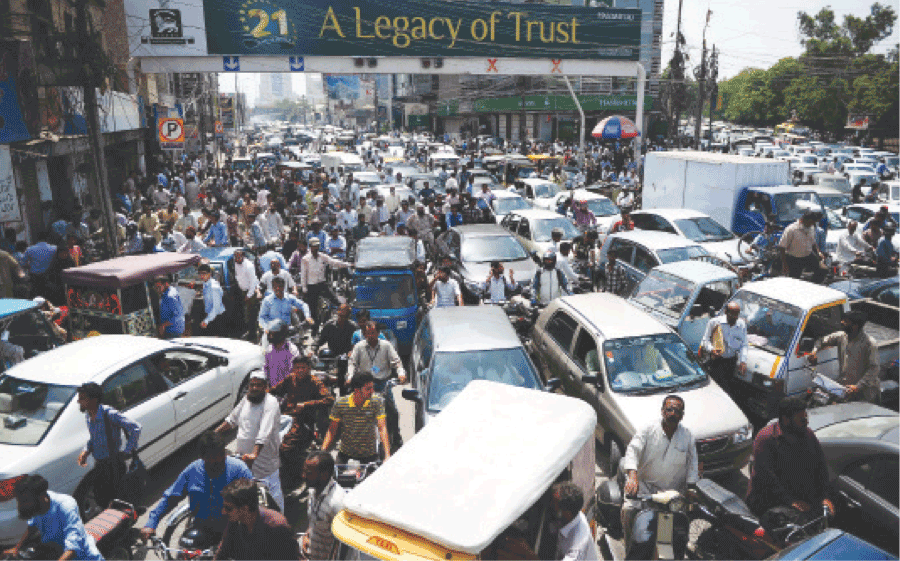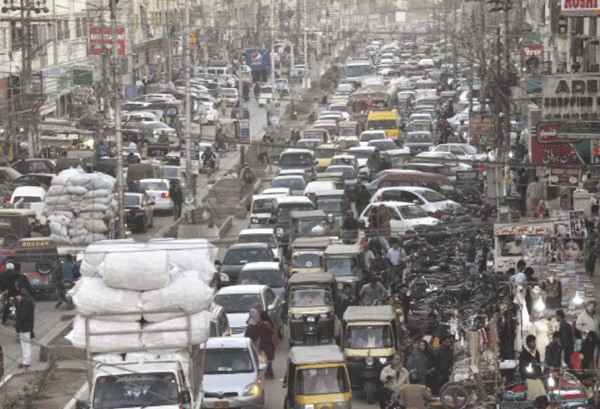Urban Chaos
By Dr Noman Ahmed | Newsline Special | Published 6 years ago
Karachiites are fully justified in their complaint that no tier of government – federal, provincial or local – has been effective enough to address their most essential problems. Among the common sectors of performance, transport is foremost. Clogged streets, waiting droves of people at bus stops, motorbikes with more than three riders, overloaded buses and mini-buses are a common sight. But visitors to Karachi can also find the choicest of private cars, imported from all across the globe, on the streets. Experiencing Karachi through the main city thoroughfares is revealing in more ways than one.

The more articulate looking yuppies tend to drive fast, though occasionally making use of indicators and other control systems. The neo-urban driver breed, captives of the begum sahibs, is the most ruthless of all. With their crude driving skills that are barely enough to shackle the monster, they can be observed turning, screeching and honking crazily along the busy streets of Karachi. The mighty feudals can be routinely spotted behind the tinted glasses of high-speed cruisers, at times with a mini motorcade of their own. Bureaucrats and senior police officers have the same profile as their landlord cronies, while moving on the roads.
Pedestrians, cyclists and motorcyclists can be found running for their lives, whenever confronted by these haughty folks. Ordinary people can also be seen, huddled in rickshaws that weave in and out of traffic on major streets. These vehicles serve as public transport, alongside a few rickety and overcrowded buses/mini buses. The bus rapid transit (BRT), much trumpeted by different government functionaries, remains an elusive dream.
 Accessibility and physical connectivity are prime considerations in the efficient performance of cities. These factors also constitute a vital consideration with respect to social justice. The rich and powerful are usually found to control public resources that are diverted towards projects and programmes expected to generate limited benefits. For instance, the Lyari Expressway was constructed to facilitate fast movement of cars and other similar vehicles. It cost more than 23 billion rupees, four times the initial estimate. The maximum number of vehicles that are likely to use this corridor is not more than a few thousands per day in either direction.
Accessibility and physical connectivity are prime considerations in the efficient performance of cities. These factors also constitute a vital consideration with respect to social justice. The rich and powerful are usually found to control public resources that are diverted towards projects and programmes expected to generate limited benefits. For instance, the Lyari Expressway was constructed to facilitate fast movement of cars and other similar vehicles. It cost more than 23 billion rupees, four times the initial estimate. The maximum number of vehicles that are likely to use this corridor is not more than a few thousands per day in either direction.
In contrast, ordinary citizens generate more than 20 million work trips that need to be serviced through public transport. Independent experts are of the view that even if half of this amount had been spent on acquiring ordinary buses, the citizens may have received significant relief in their daily commute. The BRT, if and when completed, will only account for nine percent of the total work trips. It is estimated to cost over Rs. 169 billion!
Unfortunately our political-decision-makers are entirely captive in the hands of influential consultants and investors in the domain of public transport.
In their usual functioning, political functionaries respond to the marketing gimmicks of the investors instead of paying attention to the actual needs of the people of Karachi.
For instance, the short-sighted yellow cab scheme, which was begun in the 1990s, had a terrible consequence on the overall economy of the country, including Karachi. A sizable chunk of the banking capital was diverted towards costly purchases – including the import of motor cars. Taxis constitute a para transit mode which have a limited impact on the overall commuting needs. Thus the scheme was not able to generate any worthwhile and sustainable outcome on the movement of ordinary people. The rising number of motor-bikes and cars is soon going to choke the already run-down roads and streets of Karachi. No assistance is extended to the common bus-operators who desperately need credit assistance and designated terminal spaces to park and service their vehicles.
Public transport cannot be facilitated without strong and well-managed institutions. Karachi has memories of some of these service-provision companies or corporations that ran well for some time but eventually fell apart due to various reasons. The Karachi Transport Corporation, the Sindh Road Transport Corporation and the Karachi Public Transport Society are some examples. These entities ran buses for many years but eventually fell apart due to bad governance and inappropriate management controls. Poor maintenance of bus fleets, limited incentives to the staff, and internal corruption and mismanagement did not allow these institutions to survive.

It must be remembered that the public transport is a service that cannot ensure profits. However, if managed efficiently and cautiously, it has the possibility of survival and generating operating revenue. The need of the hour is to build the capacity of existing bus and mini-bus service providers through financial assistance, capacity-building in technical and managerial aspects, instituting a working subsidy and extending corresponding advantages such as the allocation of proper terminal spaces in the public domain.
If managed properly, a good bus fleet is the answer to Karachi’s transport problems. This is not only an economical option, as compared to the expensive projects currently being contemplated, but it is also capable of bridging the social divide. If decent and efficient public buses were available, many car-users would use them due to their cumulative benefits. Besides, the Karachi Circular Railways (KCR) must be re-visited for a cost effective and efficient revival. Many regimes, including the present one, have made tall promises around KCR but with little success.
Karachi has developed in a manner that the high income groups live close to the city centre or major work locations. Lower income groups are left with limited options and thus reside far away from their workplaces. A sizable part of their meagre incomes is spent on bus / minibus fares. A peon living in Orangi spends half of his salary on transport simply to maintain his job. Contrarily, a CEO of a multinational, who resides in Defence Society and goes to work in Clifton, spends a fraction of his income on transport.
Such anomalies merit review on an urgent basis. Intelligently worked out financial management solutions can be of relevance.
Specialised outlets of fuel for filling public vehicles, fare rate adjustments, motor vehicle tax exemptions for public transport vehicles and loans with cheaper financial costs to transporters are some options. Besides, the government must consider raising the level of motor vehicle tax for private cars so that the rich may balance the cost of their luxury with the poor.
Transport and land use are integral variables. If the Karachi administration intends to maintain an equilibrium between these two essentials, some critical adjustments must be pursued. Land-use decisions, especially with reference to changes, must be made after a detailed transportation analysis. The ‘through’ or fast moving traffic should be allowed to continue unaltered. Public transport should be assigned priority of movement and parking in all the residential and commercial areas. Speed limits and road section alignments should be worked out in such a way that public transport moves without hindrance and interference.

In many cities around the world, the creation of exclusive bus lanes has proved to be useful. Choice and design of public transport vehicles, signalisation and synchronisation of vehicle movement and alignment of routes are a few important matters that need to be intelligently handled.
Karachi attracts hundreds of thousands of single males who become part of its informal work force. Many of them work in the transport sector. Thus public transport, like all other types of transport, is driven by illiterate and semi-trained drivers. Many of them only understand the basics of vehicle operation without even any rudimentary understanding of the traffic system and signals. It is ironic to note that such a vital service of our urban performance is handled in such a medieval fashion.
Driving attitudes have a major impact on the efficiency of transport systems. Many problems related to traffic jams, congested road space, noise pollution due to pressure horns/tape recording and accidents can be curtailed by proper driver education. Technology can be employed for traffic monitoring. Tracking devices and street cameras can be used to document traffic offences, especially those committed by drivers of public transport vehicles, as well as private vehicles that operate on the wrong side of the street. In addition, the value of non-motorised transport such as bicycles is very important. For short and medium-range trips, bicycles can become a cheap and effective mode. Many forward-looking cities such as Geneva in Switzerland and Bogotá in Colombia have applied them. There is no reason why these people/ environment-friendly solutions cannot be applied in Karachi.
Karachi can resolve the issues of commuting through very simple and time-tested solutions. These solutions have been applied in various parts of the developed and developing world and found to be effective. Scores of research studies and documentation are available in universities and institutes of repute that establish the validity and significance of people-friendly solutions in respect of the transport sector. If the present regime is really interested to address the plight of common people, then low profile and cost-effective solutions must be given priority in implementation. It shall help ease out some of the burden that the masses have to shoulder in a bid to lead a decent life.


